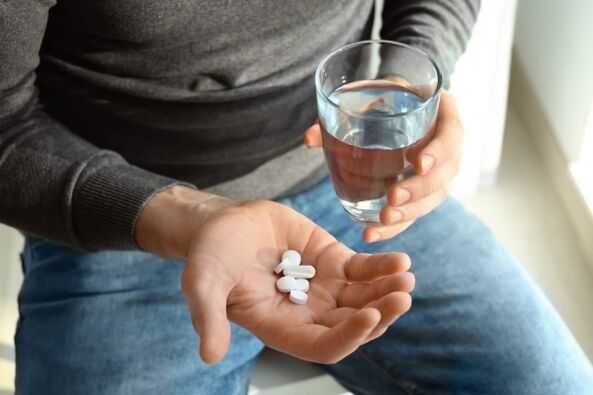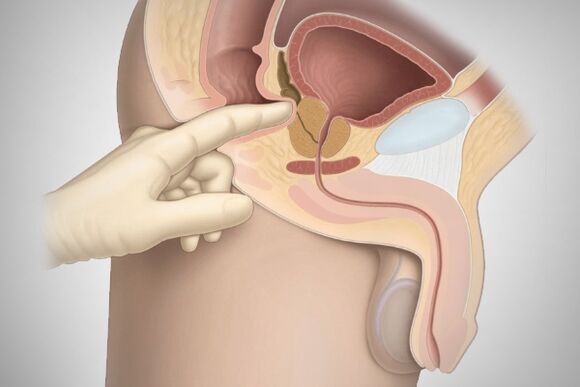Sometimes men are faced with unpleasant diseases such as bacterial prostatitis. To begin treatment in a timely manner, it is important to know what diagnosable signs of the disease, and what diagnostics and therapies are needed.
Bacterial prostatitis is an infectious disease of the prostate gland. Symptoms of the disease include pain in the perineum, increased body temperature, body intoxication and other symptoms. Such a condition may require treatment in an emergency hospital, as it can pose a threat to the health and life of the patient.
Forms of bacterial prostatitis
Depending on the course and the symptoms shown, bacterial prostatitis is divided into two forms - acute and chronic.
Sharp
The acute form manifests itself unexpectedly and is accompanied by a variety of unpleasant symptoms. Acute forms of bacterial prostatitis require immediate medical treatment. This pathological process is provoked by Escherichia coli, staphylococci, enterobacteria.
Acute prostatitis is easily diagnosed using laboratory tests. Severe symptoms and clinical picture allow an accurate diagnosis. Treat this form of prostatitis in a complex way using medication and physiotherapy.
Chronicle
Chronic bacterial prostatitis has pathogenic pathogens that can be determined using laboratory tests and studies. The main pathogens are gonococci, chlamydia, ureaplasma, mycoplasma. The inflammatory process can also be caused by tuberculosis bacteria or fungi of the genus Candida, if the man is suffering from HIV.
Types of bacterial prostatitis
Bacterial prostatitis is classified based on the type of pathogen:
- tuberculous (Kill's bacillus);
- gonorrheal (gonococci);
- fungi (various types of fungi);
- chlamydia (chlamydia);
- viral (herpes -causing agents, human papillomavirus, influenza);
- mixed (several different infections).
It is possible to determine what exactly the causative agent is only in laboratory conditions, because the symptoms are the same for everyone.
Causes and risk factors
Bacteria enter the prostate gland, causing acute or chronic prostatitis. Sexually transmitted diseases can also cause this disease. In some cases, the cause cannot be determined.
The causative agentBacterial prostatitis is considered:
- colibacillus;
- klebsiella;
- Proteus;
- enterococcus feces;
- Pseudomonas aeruginosa.
Possiblybecause of microbiologyprostatitis is:
- staphylococci (saprophytic, golden, epidermal);
- genital mycoplasma;
- chlamydia trachomatis;
- ureaplasma;
- Trichomonas.
KErisk factorsProstate gland infection with subsequent development of inflammatory processes in the form of one or another form of bacterial prostatitis are:
- intraprostatic reflux (reflux of urine into the prostate gland during urination);
- pelvic injuries;
- unprotected anal sex;
- urinary tract infections;
- have a deep urethral catheter or intermittent bladder catheterization;
- diagnostic interventions and transurethral therapy;
- HIV AIDS;
- past biopsy of the prostate.
Symptoms of Bacterial Prostatitis
Usually, with bacterial prostatitis, the symptoms are so obvious that it is difficult not to notice them. Signs of the disease include:
- high body temperature (in the anus is usually higher than in the armpits);
- fever and chills;
- difficult and painful urination, especially at night;
- the possibility of the development of constipation due to enlargement of the prostate gland;
- pain in the lower part of the body (lower back, perineum, lower abdomen);
- general intoxication of the body;
- out of the urethra and blood in the semen.

Stages of bacterial prostatitis
The clinical picture of bacterial prostatitis is shown based on the stage of the disease and the degree of involvement of prostate tissue in the inflammatory process. Share:
- Primary or catarrhal prostatitis.It is characterized by inflammation of the walls of the prostate gland. It is very possible to cure it with antibiotics in 10 days.
- Secondary or follicular.It is characterized by the formation of abscesses on the glandular tissue. It is accompanied by high fever. This form is also effectively treated with antibacterial drugs.
- Tertiary or parenchymal.The pathological process at this stage extends to all organs - the prostate enlarges, swells and deforms. If you do not take timely treatment, then the tertiary stage can develop into chronic prostatitis.
Possible complications and consequences for men
Consequences and complications of bacterial prostatitis include:
- vesiculitis (inflammation of the seminal vesicles) - manifested by groin pain, premature ejaculation, painful erections;
- colicitis (inflammation of the seminal tuberculosis) - differs in various symptoms - burning and tingling of the posterior urethra, painful sensation during orgasm, blood in the semen;
- potential violations;
- prostate sclerosis;
- infertility;
- cyst prostate;
- prostate abscess;
- stones in the prostate gland.
Chronic pelvic pain syndrome is one of the most severe consequences of chronic prostatitis.
Asymptomatic inflammation is the mildest form if there are no complaints. This type of prostatitis is diagnosed with the development of complications of reproductive function.
Is bacterial prostatitis dangerous for women?
Prostatitis in women does not occur, but serious consequences are common. If a man suffers from bacterial prostatitis, it is irresponsible to say that a woman is not in danger: chlamydia, ureaplasma, Trichomonas, mycoplasma, gonococcus, gardnerella and other infections received by his partner pose a serious danger to a woman and lead to the development of various diseasesgynecology.
Which doctor is treating?
Urologistis considered a leading specialist dealing with the diagnosis and treatment of pathological conditions of the genitourinary system.
Andrologist.Although andrology belongs to a fairly young branch of medicine, specialists in this field are gradually taking their place in the treatment of diseases of the male genitourinary system. The advantage of this doctor is its narrow focus. Unlike urologists who treat diseases of the male and female genitourinary systems, these andrologists are exclusively in male problems.
Diagnostics of bacterial prostatitis
If bacterial prostatitis is suspected, a number of examinations are performed, including:
- scrap and brooms for infections;
- plants for flora and antibiotic sensitivity;
- general blood tests help detect inflammatory processes, when there is an increase in the number of leukocytes, an increase in ESR;
- spermogram, which examines a decrease in the number of spermatozoa, violation of their movement;
- three -glass urine samples (studying inflammatory changes in urine);
- general urine analysis;
- analysis of prostate secretion;
- uroflowmetry - observation of daily urine volume.
The doctor will be able to assess how much the prostate is enlarged with a digital rectal examination. To clarify the diagnosis, the doctor may refer you to a transrectal ultrasound scan.
Bacterial Prostatitis Treatment
As therapy for bacterial prostatitis, medication, physiotherapy, folk remedies are prescribed, and in severe cases, surgery.
Drug treatment
Medical treatment of prostatitis is carried out using various groups of drugs. These can be antibiotics to neutralize pathogens. However, they do not always help, because the prostate gland is characterized by poor absorption of antibiotics from the group of protected penicillins, fluoroquinolones.
The course of treatment is usually 10-14 days, and must be completed without fail, because if bacterial prostatitis is not treated, it will reappear. Vitamins and medications are also prescribed to strengthen the immune system.

Surgical intervention
Doctors recommend surgery for prostatitis if no results are achieved in treating the patient with medication, physiotherapy or alternative treatment methods.
Surgical interventions include the following procedures:
- Transurethral resection of the prostate.The inside of the organ is removed. Surgery is the most commonly used and best endoscopic treatment for benign prostatic hyperplasia.
To perform this intervention, patients perform a number of tests, including blood and urine tests. The operation is performed under spinal anesthesia, but general anesthesia can also be used. There were no postoperative scars. Among its disadvantages is painful urination in the first days after the procedure. - Laser surgery.Lasers damage diseased tissue. At the same time, the size of the prostate decreases, and the blood vessels are "closed" and do not bleed. The operation was performed without incisions, and the postoperative period was only three days. Prior to the intervention, blood and urine tests were performed, as well as a urinary tract ultrasound and, as determined by the doctor, a prostate biopsy was performed.
This method is not effective if the prostate volume is large. - Open prostatectomy.Surgery is performed in cases where the prostate is greatly enlarged, in case of complications and in case of damage to the bladder.
The surgeon makes an incision either in the lower abdomen or between the scrotum and anus. Either part of the prostate is removed, or completely.
Prior to surgery, ultrasound, MRI and cytoscopy are performed, as well as blood and urine tests and prostate -specific antigen testing.
One of the advantages of surgery is its effectiveness in treating prostate and related problems. And from the cons - a long postoperative recovery period (more than a month), as well as problems with erectile function. - Transurethral prostate gland resection.The doctor does not remove the prostate tissue, but only makes an incision to relieve pressure on the urethra, thus making it easier to urinate. Prior to surgery, blood and urine tests are performed, as well as urinary tract ultrasound.
Advantages of the procedure - relieved prostatitis symptoms without the risk of retrograde ejaculation, long -term recovery is not required. The disadvantage - prostatitis still needs to be treated. - Drainage of prostate abscess.The doctor opens the abscess through the perineum or rectum, dissects the skin and subcutaneous tissue and inserts a drainage into the cavity with the pus to remove.
Prior to surgery, a consultation with a proctologist is performed, blood and urine tests are taken.
The advantages of surgery include the absence of risk of loss of sexual function. The disadvantage is that the abscess cannot be completely removed, and the bacteria can spread throughout the body.
Prostatitis surgery in men is usually the last resort for chronic bacterial prostatitis associated with complications in any form.
Physiotherapy
In the complex treatment of patients with a diagnosis of prostatitis, the method of physical influence is very important. As a result of the physiotherapy procedure, the following are improved:
- blood flow;
- lymphatic drainage, which contributes to the elimination of damage products of microorganisms;
- blood and lymph circulation, which causes inflammatory infiltration to be resolved;
- outflow of blood and lymph, which helps reduce congestion in the pelvis;
- metabolism;
- cell membrane activity, which induces the penetration of active drugs into cells.
Physiotherapy for bacterial prostatitis includes the following methods:
- Electrophoresis.Effects on the body with ions, which help relieve inflammation and relieve pain.
- Laser physiotherapy.Lasers help relieve perineal pain and increase blood flow to the pelvic organs. It kills bacteria and removes the waste of harmful organisms.
- Magnetotherapy.During the performance of this procedure, tissue permeability is improved, and the effectiveness of drug therapy is significantly increased. Additionally, with the help of magnetotherapy, hemodynamics and congestion are stopped.
Exercise for bacterial prostatitis
Training for chronic prostatitis causes the muscles of the pelvic area to contract, which guarantees intra-abdominal pressure differences. This smoothens the blood flow to the prostate. Exercise calms the nervous system, makes the adrenal glands function and eliminates the residual effects of inflammatory diseases on the prostate.
You can do the following exercises at home:
- The man sat on a rubber ball and rolled from left to right, slightly soaring. It helps strengthen the pelvic and oblique muscles.
- Kegel training. For 5-10 seconds, tighten your back as much as possible, and then relax the muscles. This exercise is done 20-50 times.
- Lie on your back, bend your knees and lean your heels on the floor. Lift the pelvis slowly while keeping your upper back flat on the floor. When the pelvis is at its top point, you need to freeze for 15 seconds, and then return to its original position. The number of repetitions is 10-15 times.
Doing the sequence
To achieve the result, exercises are performed daily, and they are also equipped with prostate massage, which can be done independently and with the help of a special masseur.
Prostate self -massage is performed as follows:
- Drink one liter of water an hour before the procedure to fill the bladder.
- Cleanse the intestines with an enema based on a solution of potassium permanganate or an infusion of chamomile. The crotch should be rinsed.
- Hands should be washed clean and nails should be trimmed short.
- You will need to wear gloves or a condom on the fingers that will be used for the massage.
- The rubber surface of the protective layer is lubricated with petroleum jelly, grease or baby cream.
- Lie in a comfortable position and insert your fingers into the anus to a depth of 5 cm.
- On the front wall, you can feel the prostate gland and begin to stimulate it with a light stroke from the side to the center.
- In hard areas, the pressure gradually increases, and in soft areas, the pressure decreases.
- In the final stage, a caressing motion is made downward along the middle sulcus.
- Pull your fingers gently from the anus.

During the massage, 3-5 drops of fluid (prostate juice) should be released. Immediately after the massage, you need to go to the toilet and empty the bladder.
Diet therapy
With prostatitis, it is necessary to reduce alcohol and cigarette consumption as much as possible. Also, doctors recommend not to include in the diet:
- fatty foods, especially meat, because fat is a source of "bad" cholesterol, which disrupts blood circulation and negatively affects the prostate;
- energy and synthetic drinks;
- spices;
- spicy and smoked.
It is best to eat boiled and steamed foods, lots of vegetables and herbs.
Folk remedies
Pumpkin seeds.Pumpkin seeds are an old remedy for prostatitis. They contain a lot of zinc, which is needed by the male body. You need to eat 30 pills daily before meals.
Hazel Branch.Boil a few stalks of hazel with leaves in water for 20 minutes, bring to a boil until the broth acquires a reddish-brown color. For the cure, a weekly course is enough.
Aspen skin.Aspen tree bark must be collected at the beginning of the rubber flow time, before the buds bloom. This is about the second half of April. Dry the bark in the oven, take 100 g, grind and put in a half -liter jar. Pour 200 g of vodka until the bark is completely covered. Cover the jar and place in a dark place for 2 weeks. Strain after 2 weeks. Take 1 teaspoon in three courses of three weeks with a break of 10 days.
Prognosis for bacterial prostatitis
The prognosis for prostatitis of bacterial origin depends on the stage and type of disease. The duration of the disease also affects the prognosis - the longer the inflammation is maintained, the longer it takes to treat the complications of prostatitis.
In acute prostatitis, the prognosis is good. Chronic bacterial prostatitis often takes the form of recurrence, although conservative therapy is prescribed. With long -term treatment of the chronic form, potential changes may occur.
Preventive measures
Prevention of bacterial prostatitis can be divided into primary and secondary.
Prevention of major prostatitis:
- healthy lifestyle;
- good diet;
- Play sports.
Preventive measures at home are important - do exercises that activate blood flow to the troubled organs and improve muscle tone.
Also, men should learn Kegel exercises. They were developed for women’s postpartum recovery, but they were used to train a man’s anal and rectal muscles.
Useful gymnastic exercises: bike, birch, bridge, candle. They train the pelvic muscles. It is recommended to do leg swings, breath holding exercises, and contrast baths.
Prevention of secondary prostatitis:
- drug treatment;
- periodic examination by a urologist, regardless of manifestations;
- in the year after treatment, undergo an examination every quarter, then - once every six months.
For secondary prevention, rectal suppositories are used. They act through the rectum. Usually, this drug has few contraindications. Also, to prevent recurrence of bacterial prostatitis, biologically active drugs are prescribed.
The sooner prostatitis is detected, the easier it is to cure. Therefore, do not neglect regular visits to the doctor. After diagnosis, the doctor will select the appropriate medication and prescribe a course of therapy. If the disease persists, timely medication will relieve symptoms quickly and help you stay active and functioning.































